A Comprehensive Look at Hessa Tower Photography
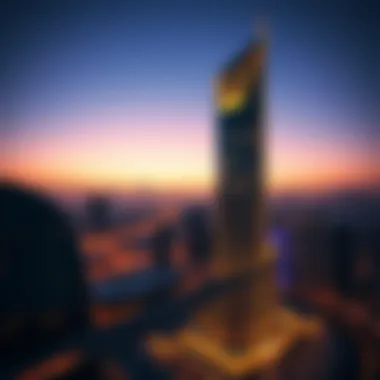
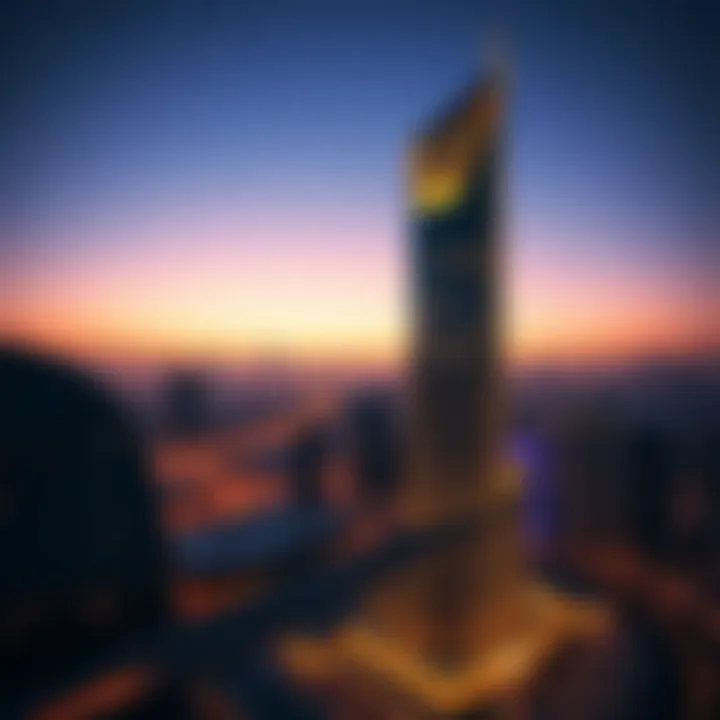
Intro
The Hessa Tower, located in the bustling city of Dubai, stands as a testament to modern architectural prowess. As the skyline continues to evolve, this structure not only adds to the aesthetic beauty of the area but also encapsulates the cultural essence of its surroundings. This piece aims to illuminate the world of Hessa Tower through the lens of photography, capturing not only the design and structure but also the stories woven into its very foundation.
When we think about architectural photography, it goes beyond mere images; it encompasses a narrative, an atmosphere, and a communion between the observer and the oddities of structure. Understanding the nuances that make Hessa Tower a landmark involves looking beyond its glass facade to appreciate the interplay of light, shadows, and the urban expanse that embraces it.
This article will guide you through a photographic exploration, highlighting the tower's main features while shedding light on broader themes within Dubai's architectural landscape. Here, we won't just skim the surface; we aim to dive deep into the visual drama and the profound implications of what these photographs represent for investors, homeowners, and anyone intrigued by contemporary architecture.
In embarking on this journey, it’s vital to recognize the layers of meaning behind each image.
Photography captures a moment, but when done thoughtfully, it also evokes emotion, raises questions, and ignites curiosity about our built environment. With that said, let's dive into the Hessa Tower's story as told through various photographs and their contexts.
Prelude to Hessa Tower
Hessa Tower stands as more than just a tall structure in Dubai; it’s a monumental blend of design, functionality, and cultural value that beckons exploration. The towering silhouette cuts a striking figure against the city’s skyline, representing a confluence of modern architecture and traditional influences. This section sets the stage for an in-depth exploration of the architectural jewel that is Hessa Tower, surrounding it with narrative richness.
The significance of Hessa Tower goes beyond mere aesthetics or geographic positioning. It symbolizes a thriving urban environment that continues to evolve at lightning speed. For investors, homeowners, and industry professionals, understanding its essence is key. Photographs of the tower serve as a visual documentation of an era defined by ambition and creativity.
Location and Significance
Nestled in the bustling heart of Dubai, Hessa Tower can be found at a pivotal intersection, making it accessible and prominent. The juxtaposition of luxury and functionality in its vicinity mirrors the core values of the city itself. Both upward and outward, Hessa Tower invites intrigue, promising not only a place to live and work but also a unique vantage point from which to observe Dubai’s ever-changing landscape. It is a focal point for discussions around urbanization, sustainability, and architectural innovation.
Additionally, its close proximity to transport hubs, shopping centers, and cultural landmarks assures its relevance in the urban tapestry. The significance of this tower extends far and wide; it not only enriches Dubai’s skyline but also fosters community interaction and engagement, reflecting the dynamic spirit of its people.
Architectural Overview
Designed by visionary architects, Hessa Tower showcases a harmonious blend of contemporary elements with nods to traditional design. The facade is not just a protective covering; it tells a story. Each curve and angle has been meticulously crafted, representing cultural nuances while meeting modern demands. This characteristic makes Hessa Tower a perfect subject for photography, as each image captured speaks volumes about its design philosophy.
The interior spaces harness natural light to enhance the experience of their inhabitants. Open layouts and innovative materials promote both functionality and aesthetics. Perspectives gained through photography reveal the building's ability to adapt to its users' needs without sacrificing elegance. For those seeking a keen understanding of architectural trends, Hessa Tower serves as a textbook case of how to merge the past and future.
"Architecture is not just about building, it’s about creating a sense of place and belonging. Hessa Tower does precisely that in the heart of Dubai."
In summary, Hessa Tower is not merely a structure; it is a reflection of urban life in Dubai, its unique challenges, and the pathways that have been forged to address them. The tower inspires discussions around contemporary architecture, and its visual representation through photography provides invaluable insight into its role within the broader architectural dialogue.
The Role of Photography in Architectural Documentation
Photography possesses a significant role in the realm of architectural documentation. Particularly when discussing structures like Hessa Tower, imagery serves not just as a record but as a narrative enhancer that captures the intricate details of form and function. The way Hessa Tower stands resilient against the backdrop of a bustling Dubai skyline can be conveyed through various photographic methods that add layers of meaning to the stillness of the buildings.
The importance of quality images cannot be overstated. They do more than just depict; they tell stories, evoke emotions, and invite interpretation. High-quality photographs possess the power to communicate architectural intentions, materiality, and the atmosphere of spaces. This visual medium allows for an appreciation that pure text fails to convey, creating an immersive experience for the viewer, be it investors, homeowners, or professionals.
Understanding Architectural Photography
Architectural photography is an art that combines technical prowess with the ability to convey the essence of spaces both indoors and outdoors. It requires not just an understanding of composition and lighting but also a comprehensive knowledge of architectural principles. Effective architectural photography can elevate a simple structure to an iconic representation, making it a crucial tool in marketing and documentation alike.
In capturing Hessa Tower, photographers often utilize wide-angle lenses to encapsulate the grandeur of the façade, while focusing on unique features, like the interplay of light during the golden hour. This application enhances the viewer’s experience, drawing them into the complexity of the structure.
Photography as an Art Form
Photography transcends mere documentation. It stands as an art form in its own right, shaping perceptions and forging connections with the audience. Through the lens, photographers can prioritize elements such as texture, color, and pattern, transforming an ordinary image into an evocative piece of art.
Consider the contrasting textures of Hessa Tower’s façade: the smooth glass juxtaposed against the rough concrete creates dialogue that can be portrayed uniquely through photography. The image can influence how one perceives its importance in the urban landscape. Additionally, composition strategies such as leading lines or the rule of thirds can guide viewer engagement, allowing the eyes to explore various aspects of the tower while simultaneously conveying a deeper message about its place within the community.
“Photography does not create a thing, it only experiences it.” — Paul Strand
In summary, photography serves as a pivotal means in architectural documentation. Its role extends far beyond simply capturing the visual essence of structures like Hessa Tower; it creates emotional investment and fosters a connection between the viewers and the architecture itself. Visitors and investors alike find themselves more engrossed when sight and emotion intertwine through the spectacles of expertly crafted images.


Analyzing Hessa Tower Photos
Understanding the nuances of Hessa Tower through photography opens up a world of insights into its architectural significance and aesthetic appeal. This section emphasizes the need to appreciate the visual detail of both the exterior and interior of Hessa Tower, as these photographs serve as both historical records and artistic interpretations. By analyzing the photos, we can grasp key aspects such as design elements, materials used, and the interplay of light that brings the structure to life. It also sparks dialogue around architectural trends and how they shape perceptions around urban environments.
Exterior Visuals
Facade Details
The facade of Hessa Tower is more than just a surface layer; it's a statement. The intricate designs, whether they be geometric patterns or smooth finishes, play a crucial role in defining the building’s character. A prominent aspect of the facade includes its reflective glass, which not only contributes to its modern aesthetic but also allows for striking reflections of the surroundings. This feature enhances the visual connection between the tower and its urban context, making it a photographic favorite. The choice of a facade with varying textures and patterns not only serves functional purposes but also captures the eye, inviting curiosity from all angles. However, the reflective surfaces can sometimes play tricks on the light, leading to images that may not accurately convey the structure's true colors and details, which, while artistically interesting, presents a challenge for purists.
Materials Used
An examination of the materials employed in the construction of Hessa Tower reveals the thoughtfulness behind its creation. The use of high-quality glass and steel is evident, contributing toward sustainability and the structure's long-lasting appeal. This choice is pivotal not only for durability but also for the aesthetic of sleek minimalism that captures the skyline’s essence. Incorporating locally sourced materials can also enhance the tower’s cultural relevance, tying it back to Dubai’s rich history. The challenge, however, lies within the maintenance of these materials, as the extreme weather may take a toll, requiring careful consideration in terms of upkeep. This detail can be subtle, but it offers investors and homeowners insight into the long-term viability of such architectural choices.
Lighting and Shadows
The interaction of lighting and shadows is a hero in the story of Hessa Tower photography. At different times of the day, the way sunlight plays on the structure not only defines its physical outline but also alters our perception of its artistic value. Early morning light can reveal softer colors, while late afternoon sun can cast dramatic shadows, reinventing the facade each hour. Capturing this fleeting beauty often requires skill and patience, making the final photographs a testament to both the tower's design and the photographer's prowess. However, the reliance on natural light can be both an advantage and disadvantage; while it enhances the aesthetic, unfavorable weather conditions can also lead to missed opportunities for capturing the building in its best light.
Interior Spaces
Design Elements
The interior architecture of Hessa Tower is characterized by clean lines and an emphasis on open spaces. Elements like arches and curves soften the stark modernity present in many high-rises, fostering a welcoming atmosphere. The design choices made here influence how residents and visitors interact with the space, inviting individuals to feel at home while also experiencing the grandeur of the tower. However, the openness can also lead to challenges in creating distinct zones, which might affect privacy—a point to consider for potential buyers or tenants.
Color Schemes
Color schemes play a pivotal role in shaping the interiors of Hessa Tower. Neutral tones dominate, creating a canvas that allows playfulness with furniture and decor. This approach encourages personalization, but it can also run the risk of feeling too sterile without distinct accent colors to warm the environment. Photographers often strive to capture these subtle hues correctly to showcase their emotional potential, as the right balance can evoke comfort and modern elegance.
Spatial Arrangement
The spatial arrangement within Hessa Tower emphasizes fluid movement, promoting a sense of connectivity amongst its various areas. Having wide hallways and strategically placed common areas enhances interactions among occupants, creating a community feel. However, for individuals or families seeking solitude, this layout may require thoughtful design in individual units to provide areas for quiet. The success of photographing such arrangements lies in capturing how these spaces function in real life, showcasing their utility and adaptability.
"Photography, particularly in architecture, transcends mere aesthetics; it's about telling the stories woven into the structures themselves."
With these insights, it's clear that the analysis of Hessa Tower photos goes beyond just appreciating beauty. It's about engaging with the building's architectural essence and understanding how it interacts with the urban landscape, creating a richer narrative that resonates with both potential investors and locals alike.
Surroundings and Contextual Photography
The surrounding environment plays a pivotal role in interpreting architectural structures, such as the Hessa Tower. Understanding the context in which the tower stands offers insights not just into its aesthetic appeal, but also its significance in the urban fabric of Dubai. This section unpacks the importance of integrating surroundings into architectural photography, underscoring the ways in which the environment enhances or contrasts with the building itself.
Hessa Tower and Its Environment
Landscaping Considerations
Landscaping around Hessa Tower is a crucial element that complements its modern design. The choice of local flora enhances the architectural narrative. It’s not just about aesthetics; the vegetation serves practical purposes as well. For one, greenery helps to soften the harsh lines of modern architecture. Selecting native plants, like the Ghaf tree, resonates with the local ecosystem, providing a relatable context for viewers. This approach is beneficial for environmental sustainability, making it a popular choice for urban planners focused on ecological balance. However, a unique challenge is maintaining this landscaping amidst the intense heat typical of Dubai, which demands careful planning and irrigation solutions.
Adjacent Structures
The structures neighboring Hessa Tower significantly contribute to the tower's overall visual impact. Skyscrapers with glass facades, like the Dubai Marina and Jumeirah Beach Residence, create a dramatic skyline backdrop. This proximity highlights the competition and harmony that exists among these architectural giants. Furthermore, the juxtaposition illustrates Dubai's rapid urban development, making it a focal point for real estate investors and urban analysts alike. However, while these adjacent structures provide a vibrant urban landscape, they can also create shadows that affect the lighting and visibility of Hessa Tower; this is a potential drawback that needs to be addressed in urban planning discussions.
Urban Interactions
The interactions between Hessa Tower and its urban settings reveal much about the architectural ethos of Dubai. The bustling streets surrounding the tower act as conduits of human activity, enabling a dialogue between the structure and those who inhabit its vicinity. The tower serves as both a landmark and a wayfinding point for visitors, enhancing navigability in the dense urban milieu. Meanwhile, public spaces nearby encourage social interaction, promoting community and engagement. That being said, the constant flow of pedestrians and vehicles can create a juxtaposition of calmness within the tower against the lively street scenes, leading to complex photographic opportunities.
Cultural Significance of Location
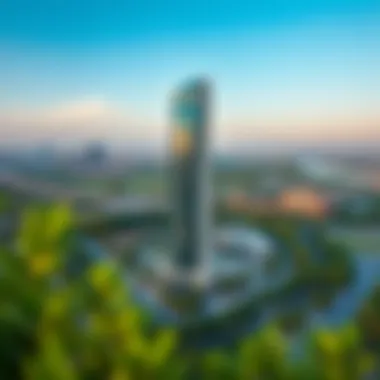

The location of Hessa Tower extends beyond mere geography; it embodies the cultural identity of the region. Situated in Dubai, a melting pot of cultures, the tower stands as a symbol of modernity while paying homage to traditional Emirati values. This blend of old and new is essential in framing international perceptions of Dubai. The juxtaposition facilitates a deeper understanding of how architecture not only shapes skylines but also stories, making it invaluable to the study of contemporary urban landscapes.
Technical Aspects of Architectural Photography
Understanding the technical elements of architectural photography is crucial when capturing the intricate details of structures like the Hessa Tower. The interplay between equipment choices and post-processing strategies can significantly influence the visual outcome of the photos. Recognizing how these components work together helps not only to document the tower's design but also to convey its artistic essence.
Equipment Used
Camera Selection
In terms of camera selection, a photographer’s choice can make or break a shot. Cameras like the Canon EOS R5 or Sony A7R IV are popular among architectural photographers due to their advanced features. They boast high resolution and dynamic range, offering the ability to capture fine details in low light and bright sunlight alike. A standout characteristic of these cameras is their adaptability. They can switch between wide angles for expansive shots and telephoto for details, ensuring versatility in a bustling urban setting like Dubai.
Advantages include:
- High resolution for detailed images.
- Good performance in varied lighting conditions.
However, they can come with a steep learning curve and price tag, which might not be suitable for amateurs.
Lenses and Filters
When considering lenses and filters, the choice of lens can significantly enhance the architectural storytelling. Wide-angle lenses often grace the list of essentials for photographing buildings, giving an expansive view that captures Hessa Tower in all its splendor. For instance, a 16-35mm lens can open up a world of possibilities, allowing for dramatic perspectives that highlight the tower's grandeur against the skyline.
On the other hand, polarizing filters are essential tools. They can reduce glare and increase color saturation, making the structure pop against the vibrant backdrop of Dubai's blue skies.
Key features of these choices include:
- A wide-angle lens captures more of the scene in a single frame.
- Polarizing filters enhance colors and reduce reflections.
Despite their advantages, wide-angle lenses can distort if not used carefully, which might affect the integrity of the architecture.
Post-Processing Techniques
Post-processing plays an equally important role in refining architectural photographs. The nuances captured in-camera can often be accentuated through software, allowing the photographer to realize their vision fully.
Editing Software
When it comes to editing software, Adobe Lightroom and Photoshop are staples in the industry. These platforms offer powerful tools for correcting perspectives, enhancing color, and sharpening images. Their ability to process RAW files is a game-changer, as photographers can extract more detail from their shots.
Why use them?
- Lightroom is user-friendly for batch editing and managing large photo libraries.
- Photoshop offers advanced editing capabilities for more intricate adjustments.
However, the learning curve can be steep for newcomers, and without a solid understanding, over-processing can lead to artificial-looking outcomes.
Image Enhancement Strategies
Image enhancement strategies such as high dynamic range (HDR) imaging and layer masking can elevate the visual quality of photos. HDR imaging allows photographers to merge multiple exposures together, capturing a greater range of light and shadow. This technique works particularly well in architectural photography, where contrast can be stark, especially on bright sunny days.
Unique aspects include:
- HDR allows for a balanced exposure throughout the photo, making details in both highlights and shadows visible.
- Layer masking enables fine-tuning of specific areas in an image without affecting the whole picture.
Nevertheless, HDR must be applied carefully; overdoing it can lead to unrealistic colors.
In summary, the technical aspects behind architectural photography are intricate yet essential. The right combination of equipment and post-processing tools not only propagates the visual documentation of structures like Hessa Tower but also enhances their narrative within the larger context of Dubai's architectural landscape, showing the evolution of urban creativity.
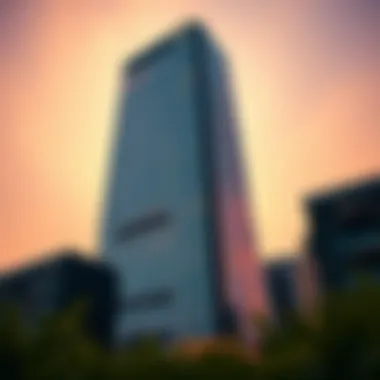
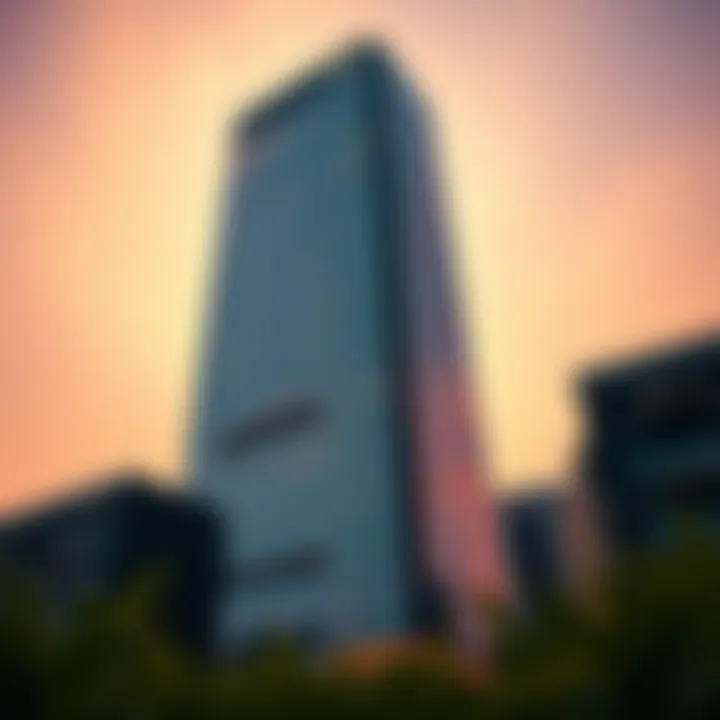
Implications of Hessa Tower in Dubai’s Skyline
The Hessa Tower stands as more than just a significant feature in Dubai's skyline; it is a testament to the city's architectural evolution and the integration of design within urban life. With its unique structure and captivating aesthetics, the tower stimulates discussions about broader architectural trends and real estate dynamics in the region. Understanding these implications provides vital insights not just into the tower itself, but also into the fabric of Dubai’s urban landscape.
Architectural Trends in Dubai
Modernism vs. Tradition
When discussing Modernism vs. Tradition, Hessa Tower embodies the modernist ideals of sleek lines and innovative materials while respecting historical architectural motifs that characterize the city. There is a key characteristic of modernism characterized by its emphasis on functionality and minimalism. This is highly influential in contemporary architecture, shaping the public perception of structures in urban settings. Traditional designs often draw from the rich cultural heritage, lending a recognizable identity to new developments. In Hessa Tower, we find a skillful blend of these two worlds, providing a visual dialogue between past and present.
However, while modernism often wins kudos for its clean aesthetics and efficient use of space, the challenge lies in ensuring that such designs resonate culturally. The advantages include a fresh narrative accompanying new developments, while disadvantages might include criticism for overlooking the historicity that attracts a diverse population to the city.
Sustainability Considerations
In the modern architectural scene, Sustainability Considerations have taken center stage. Hessa Tower is not only designed with aesthetics in mind but also incorporates sustainable practices that reflect current needs for ecological mindfulness. This feature is crucial, as building designs now often look toward renewable resources and energy efficiency.
The critical characteristic here revolves around eco-friendly materials and technologies. This choice is essential for the article as it speaks to a growing trend among investors and developers who prioritize environmentally responsible practices. The unique aspect of such considerations is their potential to reduce operational costs over time while enhancing overall building performance. These advantages promote long-term financial viability, despite initial investments that might seem hefty. Penalties for ignoring sustainability can manifest in the form of regulatory hurdles and rising operational costs, making it an unfavorable option in today's market.
Impact on Real Estate Market
Investment Opportunities
The architectural charisma of Hessa Tower opens Investment Opportunities that appeal to various stakeholder interests. The tower's presence elevates the surrounding property values, attracting both local and foreign investors. Hence, the allure of such iconic structures lies not only in their immediate returns but also in their capacity to bolster collective real estate value in the area.
Key characteristics of these investment opportunities include the inherent prestige that comes with ownership or proximity to an architectural landmark. It's beneficial for the article's audience, including potential investors, as such properties tend to appreciate over time and maintain a desirable market appeal. The unique feature of Hessa Tower in this context is its location; being situated in an up-and-coming district, it is likelier to ensure substantial long-term returns. While the advantages are clear, it's important to exercise caution, as fluctuations in real estate markets can impact investments heavily.
Future Development Projections
Looking ahead, the Future Development Projections surrounding Hessa Tower suggest a continued transformation of Dubai's skyline. The tower itself serves as an anchor point for prospective projects, shaping a vision for urban growth and architectural integrity. The crucial characteristic of these projections includes their reliance on demographic growth and economic stability, setting the foundation for future endeavors.
Such foresight is beneficial to article readers like real estate analysts and investors who aim to capitalize on emerging trends. Several unique features of future projections hinge on the evolving demands of urban development, encapsulating changing residential preferences and commercial imperatives. However, uncertainties surrounding global economic conditions may pose challenges, compelling stakeholders to carefully evaluate potential risks alongside anticipated benefits.
Closure
The significance of concluding an article about Hessa Tower cannot be overstated. In wrapping up the discussion, it's crucial to summarize the essence of what has been explored and reflect on the broader implications of such architectural achievements. Hessa Tower stands as a testament to Dubai’s relentless pursuit of modernity, embodying not only a physical presence but also the aspirations of a rapidly evolving city.
One cannot help but appreciate how the tower contributes to the architectural identity of Dubai. It serves as a landmark that frames the skyline while inviting dialogue about architectural innovation and cultural representation. By analyzing the interplay of design elements and its visual impact, we become aware of how Hessa Tower is not merely a building; it’s a symbol of progress and a canvas for architectural expression. This resonates deeply, especially with investors and professionals looking for opportunities within the ever-changing real estate market.
Reflecting on Architectural Identity
Hessa Tower reflects a blend of contemporary flair and cultural heritage that speaks volumes about Dubai's architectural identity. As observers delve into its design, it's clear that every line and angle has been carefully crafted, not just to dazzle the eye but to convey a story. The tower doesn't exist in isolation; it mirrors the ethos of a city that embraces the future without forgetting its roots.
Key considerations include:
- The fusion of modernist aesthetics with traditional motifs.
- The significance of public spaces created around the tower.
- How the tower influences local culture and community interactions.
These elements coalesce to form a narrative about identity, one that it's dynamic and continuously evolving. As global investors and homeowners evaluate the architectural landscape of Dubai, Hessa Tower's design and significance are crucial factors in understanding the shifting narrative around urban development in the region.
The Future of Hessa Tower and Dubai Architecture
Looking ahead, Hessa Tower is positioned at the forefront of Dubai's architectural future. The development of nearby infrastructures, the increasing emphasis on sustainability, and the demand for innovative living spaces are all factors that will shape its trajectory. As Dubai continues to grow, there is an enduring need for buildings like Hessa Tower that challenge conventional thought while aligning with environmental considerations.
Some relevant trends to keep an eye on include:
- Increased use of sustainable materials.
- Technological integration in residential and commercial spaces.
- Evolving urban landscapes that promote communal spaces.
The journey doesn’t end here, as ongoing developments and visual documentation will continue to tell the story of not just Hessa Tower but also the very essence of Dubai’s architectural narrative. The future is bright, and in it, Hessa Tower will undoubtedly play a pivotal role in shaping the skyline and cultural identity of the city it proudly represents.
"As we move forward, each new structure not only adds to our skyline but also layers more meaning to the story of our city."
A continued focus on these aspects will enhance both appreciation for and investment in Dubai's architectural landscape.







